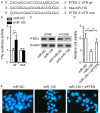MiR-130 exerts tumor suppressive function on the tumorigenesis of human non-small cell lung cancer by targeting PTEN
- PMID: 28469790
- PMCID: PMC5411933
MiR-130 exerts tumor suppressive function on the tumorigenesis of human non-small cell lung cancer by targeting PTEN
Abstract
MicroRNAs (miRNAs) have been involved in some human malignancies and correlated with tumor progression. The dysregulation of miR-130 is found in various cancers and correlated with tumor proliferation and apoptosis. However, its expression and function in non-small cell lung cancer (NSCLC) have not been investigated yet. In this study, we demonstrated that miR-130 is significantly down-regulated in NSCLC tissue samples and cell lines. Low miR-130 expression was closely associated with lymph node metastasis, late stages of disease progression and diminished survival in NSCLC patients. The up-regulation of miR-130 could significantly inhibit NSCLC cell growth and enhance cell apoptosis both in vitro and in vivo. Whereas inhibition of miR-130 exerted opposite effects. Furthermore, dual-luciferase reporter assay confirmed that PTEN was regulated by miR-130 directly, and the knockdown of PTEN markedly abrogated the anti-growth effect of miR-130. Additionally, miR-130 was found positively correlated with PTEN in NSCLC specimens. In conclusion, our results suggested that the expression of miR-130 is significantly associated with the growth and apoptosis of NSCLS cells by targeting PTEN, whilst miR-130 may be a potential therapeutic target for NSCLC treatment.
Keywords: Non-small cell lung cancer; PTEN; apoptosis; miR-130; proliferation.
Conflict of interest statement
None.
Figures





Similar articles
-
MicroRNA-92a promotes epithelial-mesenchymal transition through activation of PTEN/PI3K/AKT signaling pathway in non-small cell lung cancer metastasis.Int J Oncol. 2017 Jul;51(1):235-244. doi: 10.3892/ijo.2017.3999. Epub 2017 May 16. Int J Oncol. 2017. PMID: 28534966
-
MiR-454 promotes the progression of human non-small cell lung cancer and directly targets PTEN.Biomed Pharmacother. 2016 Jul;81:79-85. doi: 10.1016/j.biopha.2016.03.029. Epub 2016 Apr 9. Biomed Pharmacother. 2016. PMID: 27261580
-
Downregulation of N-Acetylglucosaminyltransferase GCNT3 by miR-302b-3p Decreases Non-Small Cell Lung Cancer (NSCLC) Cell Proliferation, Migration and Invasion.Cell Physiol Biochem. 2018;50(3):987-1004. doi: 10.1159/000494482. Epub 2018 Oct 24. Cell Physiol Biochem. 2018. PMID: 30355927
-
MicroRNA-21 (miR-21) represses tumor suppressor PTEN and promotes growth and invasion in non-small cell lung cancer (NSCLC).Clin Chim Acta. 2010 Jun 3;411(11-12):846-52. doi: 10.1016/j.cca.2010.02.074. Epub 2010 Mar 16. Clin Chim Acta. 2010. PMID: 20223231
-
miR-205 promotes the growth, metastasis and chemoresistance of NSCLC cells by targeting PTEN.Oncol Rep. 2013 Dec;30(6):2897-902. doi: 10.3892/or.2013.2755. Epub 2013 Sep 30. Oncol Rep. 2013. PMID: 24084898
Cited by
-
PTEN defects in cancer, from gene to protein molecular causes and therapeutic targets.Discov Oncol. 2025 Aug 28;16(1):1649. doi: 10.1007/s12672-025-03465-4. Discov Oncol. 2025. PMID: 40877546 Free PMC article. Review.
-
Long Non-Coding RNA PART1 Exerts Tumor Suppressive Functions in Glioma via Sponging miR-190a-3p and Inactivation of PTEN/AKT Pathway.Onco Targets Ther. 2020 Feb 4;13:1073-1086. doi: 10.2147/OTT.S232848. eCollection 2020. Onco Targets Ther. 2020. PMID: 32099409 Free PMC article.
-
Bone marrow mesenchymal stem cells derived miRNA-130b enhances epithelial sodium channel by targeting PTEN.Respir Res. 2020 Dec 11;21(1):329. doi: 10.1186/s12931-020-01595-7. Respir Res. 2020. PMID: 33308227 Free PMC article.
-
Recent advances on high-efficiency of microRNAs in different types of lung cancer: a comprehensive review.Cancer Cell Int. 2023 Nov 20;23(1):284. doi: 10.1186/s12935-023-03133-z. Cancer Cell Int. 2023. PMID: 37986065 Free PMC article. Review.
-
LncRNA MRPL39 inhibits cell proliferation and migration by regulating miR-130/TSC1 axis in non-small cell lung cancer.3 Biotech. 2024 May;14(5):125. doi: 10.1007/s13205-024-03975-y. Epub 2024 Apr 2. 3 Biotech. 2024. PMID: 38577417 Free PMC article.
References
-
- Planchard D, Yokoi T, McCleod MJ, Fischer JR, Kim YC, Ballas M, Shi K, Soria JC. A phase III study of durvalumab (MEDI4736) with or without tremelimumab for previously treated patients with advanced NSCLC: rationale and protocol design of the ARCTIC study. Clin Lung Cancer. 2016;17:232–236. - PubMed
-
- Moumtzi D, Lampaki S, Zarogoulidis P, Porpodis K, Lagoudi K, Hohenforst-Schmidt W, Pataka A, Tsiouda T, Zissimopoulos A, Lazaridis G, Karavasilis V, Timotheadou H, Barbetakis N, Pavlidis P, Kontakiotis T, Zarogoulidis K. Prognostic factors for long term survival in patients with advanced non-small cell lung cancer. Ann Transl Med. 2016;4:161. - PMC - PubMed
LinkOut - more resources
Full Text Sources
Research Materials
